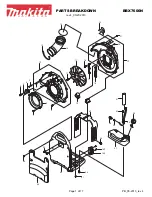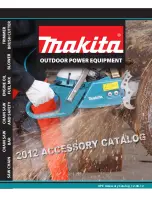
47
ENGLISH
- Rotate the cam until the belt is properly tightened
- Tighten again the cam fastening screw.
Such belt is properly tightened when pushing strongly
with a finger on the longest part the same one per-
forms a flexure ranging from mm 1 and 2.
5.3.4 SECONDARY TRANSMISSION
This transmission is illustrated in Fig. 10. The five-
groove pulley P receiving the motion from the 1
st
speed, 2
nd
speed and reverse speed belts distributes
back this motion to two worm reduction units by
means of two belts: one on the right worm reduction
unit and one on the left worm reduction unit.
5.3.5 CONTROLS AND ADJUSTMENT OF THE
SECONDARY TRANSMISSION
The steering of the machine takes place by releasing
the C1 or C2 belts from the right and left pulleys (Fig.
11). These belts are usually tensioned by the G1, G2,
G3 and G4 guide pulleys by means of the M1 and M2
springs. To steer rightward, you just have to release
the C1 belt, by opening S1 and S2. To steer leftward,
it is necessary to perform the same operation, by
opening S3 and S4. In order to have the device “ad-
justed”, it is necessary to control the following parts:
a) lower belt-braking system: it shall be at d= mm
2-3 distance from the pulleys (Fig. 10) d=2-3 mm
and it is necessary to make sure that the belts are
in normal conditions (tensioned) and that they do
not slide against it.
b) the S1S2 and S3S4 supports with the two guide
pulleys, under “normal” conditions pressed
against C1 and C2, must be arranged in such a
way so that AB is equal to =75 mm, being A and B
the two points where the M1 and M2 springs Fig.
10 are hooked.
c) with the two steering levers operated to the bot-
tom, one at a time, the belt-braking sliding blocks
W1-W2 Fig. 11 engage the pulleys groove. In or-
der to obtain this, operate as follows: pull to the
end of the stroke the steering levers (10-12 Fig. 1)
(one at a time), until AB is equal to mm 100.
At this point, bring the right and left V adjusting
screws to support S1 and S3 (those without brake
plug) and fasten them with the special lock nut.
After the adjustment, reassemble the belt guard.
Start the engine and check that the machine steers
correctly, otherwise, operate the right and/or left
V adjusting screws for a further adjustment.
WARNING
THE STEERING LEVERS (10-12 FIG. 1) MUST BE
KEPT ADJUSTED IN SUCH A WAY SO THAT, BEFORE
PULLING THE WIRE, THEY PERFORM A IDLE
STROKE (clearance) OF AT LEAST MM 5-6 MEAS-
URED WITH RELATION TO THE WIRE.
WARNING
All the V belts used on the machine are “special”;
therefore we suggest, in case it is necessary to re-
place them, to use only genuine belts.
In case of too much wear or breakage even of one
single belt, we suggest to replace both of them to
ensure a proper machine functioning.
5.3.6 CRAWLERS REPLACEMENT
(
Reference to Fig. 12).
This operation shall be performed when the crawlers
are too much worn
WARNING
To replace the crawlers, it is necessary to make
sure that the engine is shut-off, and have the ma-
chine rest on the inner part of the crawlers on a
raised firm ground and perform the following in-
structions:
- Set the nuts D1, included in the kit, on both F
threads that are on the M springs end.
- Tighten the D1 nuts until you completely close the
M springs; in this way, the crawler tension slack-
ens
- Remove the V screws that make the RT toothed
wheels of the crawler integral to the axle shafts.
- Insert from the inside a lever between the crawler
and the tension roller (A), let the crawler slide by
making it come out from its seat. Two persons are
necessary to perform this operation.
- To assemble the new crawler, wind it to the RT-A-R
wheels, and in order to ease the operation, insert a
lever from the outside of the machine between the
tension roller A and the crawler to be assembled,
by paying attention that the belt central pitches cor-
respond to the toothing of the RT driving gear.
- After this operation, loosen and remove the D1 nuts
that were previously tightened, so that the M
Summary of Contents for F 400
Page 4: ...4 1700 900 700 Fig 2 A Fig 3 5 4 1 2 6 3 7 ...
Page 5: ...5 Fig 4 1 2 3 A B 6 4 5 1 4 2 Fig 5 Fig 6 1 3 5 ...
Page 6: ...6 2 A B 1 Fig 6 a Fig 7 AR AM P K AT R F1b V L G1 G2 P5 P2 P3 P4 Q P1 F GR ...
Page 9: ...9 Fig 13 1 6 4 3 2 2 5 Fig 12 F D1 M S A R RT V ...
Page 10: ...10 3 1 1 Fig 14 ...
Page 11: ...11 1 4 2 3 9 7 6 5 8 Fig 15 7 6 5 8 11 10 ...
Page 12: ...12 Fig 17 1 2 4 6 7 5 3 Fig 16 ...
Page 13: ...13 1 4 3 5 2 Fig 18 Fig 19 A A 9 10 9 6 5 2 2 1 7 3 4 8 13 11 12 F ...
















































